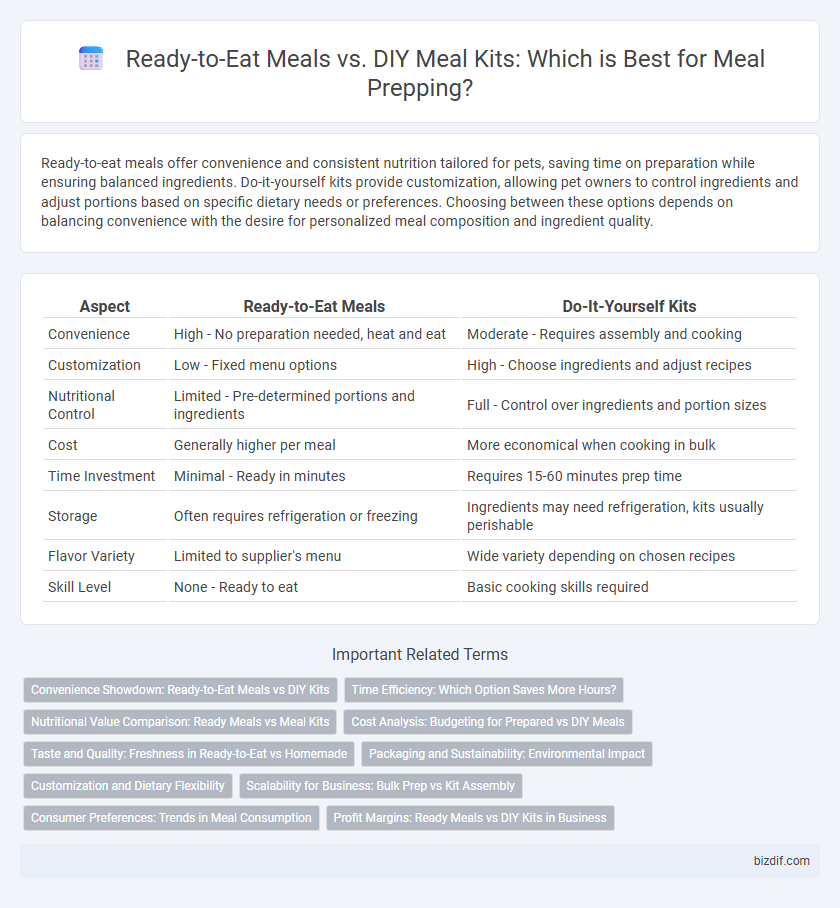Ready-to-eat meals offer convenience and consistent nutrition tailored for pets, saving time on preparation while ensuring balanced ingredients. Do-it-yourself kits provide customization, allowing pet owners to control ingredients and adjust portions based on specific dietary needs or preferences. Choosing between these options depends on balancing convenience with the desire for personalized meal composition and ingredient quality.
Table of Comparison
| Aspect | Ready-to-Eat Meals | Do-It-Yourself Kits |
|---|---|---|
| Convenience | High - No preparation needed, heat and eat | Moderate - Requires assembly and cooking |
| Customization | Low - Fixed menu options | High - Choose ingredients and adjust recipes |
| Nutritional Control | Limited - Pre-determined portions and ingredients | Full - Control over ingredients and portion sizes |
| Cost | Generally higher per meal | More economical when cooking in bulk |
| Time Investment | Minimal - Ready in minutes | Requires 15-60 minutes prep time |
| Storage | Often requires refrigeration or freezing | Ingredients may need refrigeration, kits usually perishable |
| Flavor Variety | Limited to supplier's menu | Wide variety depending on chosen recipes |
| Skill Level | None - Ready to eat | Basic cooking skills required |
Convenience Showdown: Ready-to-Eat Meals vs DIY Kits
Ready-to-eat meals offer unparalleled convenience by eliminating cooking and preparation time, making them ideal for busy lifestyles and immediate consumption. DIY meal kits require some time and effort but provide flexibility in ingredients and cooking experience, appealing to those who enjoy hands-on meal preparation. Choosing between the two depends on prioritizing speed and ease versus customization and culinary engagement.
Time Efficiency: Which Option Saves More Hours?
Ready-to-eat meals save significant time by eliminating cooking and meal assembly, offering convenience for busy schedules. Do-it-yourself kits require meal prep and cooking, which extends total time but allows customization and fresher ingredients. Studies show ready-to-eat options reduce meal preparation time by up to 70%, making them more efficient for those prioritizing time savings.
Nutritional Value Comparison: Ready Meals vs Meal Kits
Ready-to-eat meals often contain higher levels of sodium and preservatives to ensure longer shelf life, which can reduce overall nutritional quality compared to do-it-yourself meal kits. Meal kits provide fresh ingredients with controlled portions, allowing for customized nutrient intake and retention of vitamins and minerals. Studies show meal kits generally offer better nutritional profiles, including more fiber and essential nutrients, while ready meals tend to be more calorie-dense and less nutrient-diverse.
Cost Analysis: Budgeting for Prepared vs DIY Meals
Ready-to-eat meals often carry a higher price per serving compared to do-it-yourself kits due to convenience and packaging costs. DIY kits, while requiring initial ingredient purchases and time investment, generally offer more cost-effective bulk meal prepping options and reduced per-meal expenses. Budgeting for meal prep should consider long-term savings from DIY kits alongside the time and labor costs involved.
Taste and Quality: Freshness in Ready-to-Eat vs Homemade
Ready-to-eat meals offer convenience but often compromise on freshness and flavor intensity due to preservation methods and packaging. Homemade meal kits allow control over ingredient quality and cooking techniques, resulting in higher taste and nutrient retention. Choosing homemade preparation typically enhances overall meal satisfaction through personalized seasoning and freshly cooked components.
Packaging and Sustainability: Environmental Impact
Ready-to-eat meals typically use single-use plastic packaging that increases landfill waste and carbon emissions, while do-it-yourself kits often incorporate recyclable or biodegradable materials, reducing environmental footprint. Meal kits minimize food waste by precisely portioning ingredients, promoting resource efficiency and less packaging overall. Choosing sustainable packaging options in meal prepping can significantly lower environmental impact without sacrificing convenience or meal quality.
Customization and Dietary Flexibility
Ready-to-eat meals offer convenience but often lack customization, limiting dietary flexibility for specific nutrition plans or food allergies. Do-it-yourself kits provide ingredient control, enabling tailored portion sizes and accommodation of dietary restrictions such as keto, vegan, or gluten-free. Personalized meal prep kits promote healthier eating habits by allowing modifications to macros, flavors, and ingredient quality.
Scalability for Business: Bulk Prep vs Kit Assembly
Bulk meal prepping offers greater scalability for businesses by allowing mass production in centralized kitchens, reducing labor costs and optimizing ingredient sourcing. Ready-to-eat meals streamline distribution and storage, catering efficiently to high-volume orders with consistent quality control. Do-it-yourself kits require intricate assembly processes that may limit scalability due to variable consumer customization and increased packaging complexity.
Consumer Preferences: Trends in Meal Consumption
Consumer preferences in meal prepping reveal a rising trend toward ready-to-eat meals due to their convenience and time-saving benefits for busy lifestyles. Do-it-yourself kits appeal to those valuing customization, fresh ingredients, and cooking as a recreational activity. Market analytics indicate a steady growth in both segments, driven by health-conscious consumers seeking balanced nutrition alongside minimal meal preparation efforts.
Profit Margins: Ready Meals vs DIY Kits in Business
Ready-to-eat meals typically yield higher profit margins due to their convenience appeal and premium pricing, despite higher production and packaging costs. Do-it-yourself kits often have lower margins but benefit from reduced preparation expenses and appeal to budget-conscious consumers valuing customization. Businesses prioritizing scalability and customer retention may find a balanced portfolio of both products enhances overall profitability.
Ready-to-eat meals vs do-it-yourself kits Infographic

 bizdif.com
bizdif.com